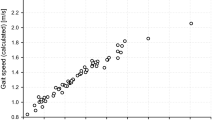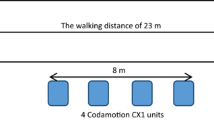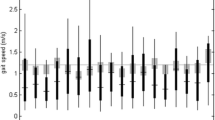Abstract
In Inertial measurement unit (IMU) based gait analysis systems, the shoe-type sensor is not commonly used, unlike trunk attached sensors. The purpose of this study was to assess the directional Stride regularity (SR) and Gait variability (GV) of data from shoe-type IMU sensors during leveled treadmill walking. The other aim was to investigate the effects of walking speed and age on directional SR and GV in an attempt to find the directional preference associated with gait stability. The DynaStabTM (IMU based gait analysis system) including Smart Balance® (shoe-type data logger) was used to collect normal gait data from forty-four subjects in their 20s (n = 20), 40s (n = 13), and 60s (n = 11). Four different walking speeds (3, 4, 5 and 6 km/h, respectively) on a treadmill were applied for one-minute of continuous leveled walking. Three linear accelerations and three angular velocities were measured with shoe-type IMU sensors. The SR (autocorrelation) and CV of ensemble data (coefficient of variation) on directional kinematics were calculated and compared with different walking speeds and ages. The results indicated that the lateral kinematics (mediolateral acceleration and yawing and rolling angular velocities) had lower stride regularity and higher gait variability than the anteroposterior and vertical kinematics across all walking speeds and ages. Significant interactions on the SRs and GVs from walking speed and age were found for only mediolateral acceleration and rolling angular velocity. Conclusively, the shoe-type IMU sensor system assessed directional SR and GV during walking conveniently. People should be careful with lateral kinematics since it is very sensitive to walking speed and age from the perspective of gait stability.
Similar content being viewed by others
References
L. Li, J. M. Haddad and J. Hamill, Stability and variability may respond differently to changes in walking speed, Hum. Mov. Sci., 24 (2005) 257–267.
C. J. Lamoth, F. J. van Deudekom, J. P. van Campen, B. A. Appels, O. J. de Vries and M. Pijnappels, Gait stability and variability measures how effects of impaired cognition and dual tasking in frail people, J. Neuroeng. Rehabil., 8 (2011) 2.
R. Moe-Nilssen, M. K. Aaslund, C. Hodt-Billington and J. L. Helbostad, Gait variability measures may represent different constructs, Gait Posture, 32 (1) (2010) 98–101.
W. Zijlstra, Assessment of spatio-temporal parameters during unconstrained walking, Eur. J. Appl. Physiol., 92 (2004) 39–44.
J. M. Hausdorff, J. D. Schaafsma, Y. Balash, A. L. Bartels, T. Gurevich and N. Giladi, Impaired regulation of stride variability in Parkinson’s disease, Exp. Brain Res., 149 (2) (2003) 187–194.
J. S. Brach, J. E. Berlin, J. M. Van Swearingen, A. B. Newman and S. A. Studenski, Too much or too little step width variability is associated with a fall history in older persons who walk at or near normal gait speed, J. Neuroeng. Rehabil., 2 (2005) 21–28.
R. Moe-Nilssen and J. L. Helbostad, Estimation of gait cycle characteristics by trunk accelerometry, J. Biomech., 37 (1) (2004) 121–126.
A. Tura, L. Rocchi, M. Raggi, A. G. Cutti and L. Chiari, Recommended number of strides for automatic assessment of gait symmetry and regularity in above-knee amputees by means of accelerometry and autocorrelation analysis, J. Neuroeng. Rehabil., 9 (2012) 11.
R. Schwesig, S. Leuchte, D. Fisher, R. Ullmann and A. Kluttig, Inertial sensor based reference gait data for healthy subjects, Gait Posture, 33 (4) (2011) 673–678.
T. Liu, Y. Inoue and K. Shibata, Development of wearable sensor system for quantitative gait analysis, Measurement, 42 (2009) 978–988.
B. Mariani, C. Hoskovec, S. Rochat, C. Büla, J. Penders and K. Aminian, 3D gait assessment in young and elderly subjects using foot-worn inertial sensors, J. Biomech., 43 (15) (2010) 2999–3006.
A. M. Sabatini, C. M. Martelloni, S. Scapellato and F. Cavallo, Assessment of walking features from foot inertial sensing, IEEE Trans. Biomed. Eng., 52 (3) (2005) 486–494.
R. Senden, B. Grimm, I. C. Heyligers, H. H. Savelberg and K. Meijer, Acceleration-based gait test for healthy subjects: reliability and reference data, Gait Posture, 30 (2) (2009) 192–196.
M. Henriksen, H. Lund, R. Moe-Nilssen, H. Bliddal and B. Danneskiod-Samsoe, Test-retest reliability of trunk accelerometric gait analysis, Gait Posture, 19 (3) (2004) 288–297.
R. Moe-Nissen, Test-retest reliability of trunk accelerometry during standing and walking, Arch. Phys. Med. Rehabil., 79 (1998) 1377–1385.
H. B. Menz, S. R. Lord and R. C. Fitzpatric, Acceleration pattern of the head and pelvis when walking on level and irregular surface, Gait Posture, 18 (1) (2003) 35–46.
R. Moe-Nilssen and J. L. Helbostad, Interstride trunk acceleration variability but not step width variability can differentiate between fit and frail older adults, Gait Posture, 21 (2) (2005) 164–170.
M. A. Townsend, Biped gait stabilization via foot placement, J. Biomech., 18 (1) (1985) 21–38.
S. J. Bamberg, A. Y. Benbasat, D. M. Scarborough, D. E. Krebs and J. A. Paradiso, Gait analysis using a shoeintegrated wireless sensor system, IEEE Trans. Inf. Technol. Biomed., 12 (4) (2008) 413–423.
J. Y. Joo, Y. K. Kim and K. Y. Park, Reliability of 3D-inertia measurement unit based shoes in gait analysis, Korean J. Sports Biomech., 25 (1) (2015) 123–130.
J. Walston, E. C. Hadley, L. Ferrucci, J. M. Guralnik, A. B. Newman, S. A. Studenski, W. B. Ershler, T. Harris and L. P. Fried, Research agenda for frailty in older adults: toward a better understanding of physiology and etiology: summary from the American geriatrics society/national institute on aging research conference on frailty in older adults, J. Am. Geriatr. Soc., 54 (2006) 991–1001.
H. Axer, M. Axer, H. Sauer, O. W. Witte and G. Hagemann, Falls and gait disorders in geriatric neurology, Clin. Neurol. Neurosurg., 112 (4) (2010) 265–274.
M. J. Hilliard, K. M. Martinez, I. Janssen, B. Edwards, M. L. Mille, Y. Zhang and M. W. Rogers, Lateral balance factors predict future falls in community-living older adults, Arch. Phys. Med. Rehabil., 89 (2008) 1708–1713.
B. E. Maki, M. A. Edmondstone and W. E. McIlroy, Agerelated differences in laterally directed compensatory stepping behavior, J. Gerontol. A Biol. Sci. Med. Sci., 55 (2000) M270–M277.
M. L. Mille, M. E. Johnson, K. M., Martinez and M. W. Rogers, Age-dependent differences in lateral balance recove rythrough protective stepping, Clin. Biomech., 20 (2005) 607–616.
D. Hamacher, D. Hamacher, W. R. Taylor, N. B. Singh and L. Schega, Towards clinical application: Repetitive sensor position recalibration for improved reliability of gait parameters, Gait Posture, 39 (4) (2014) 1146–1148.
B. Mariani, C. Hoskovec, S. Rochat, C. Bula, J. Penders and K. Aminian, 3D gait assessment in young and elderly subjects using footworn inertial sensors, J. Biomech., 43 (15) (2010) 2999–3006.
K. Parker, E. Hanada and J. Adderson, Gait variability and regularity of people with transtibial amputations, Gait Posture, 37 (2) (2003) 269–273.
A. D. Kuo, Stabilization of lateral motion in passive dynamic walking, Int. J. Robotics Res., 18 (9) (1999) 917–930.
C. E. Bauby and A. D. Kuo, Active control of lateral balance in human walking, J. Biomech., 33 (11) (2000) 1433–1440.
Y. C. Pai and J. Patton, Center of mass velocity-position predictions for balance control, J. Biomech., 30 (4) (1997) 347–354.
A. L. Hof, M. G. J. Gazendam and W. E. Sinke, The condition for dynamic stability, J. Biomech., 38 (1) (2005) 1–8.
J. S. Brach, R. Berthold, R. Craik, J. M. Van Swearingen and A. B. Newman, Gait variability in community-dwelling older adults, J. Am. Geriatr. Soc., 49 (2001) 1646–1650.
N. Sekiya, H. Nagasaki, H. Ito and T. Furuna, Optimal walking in terms of variability in step length, J. Orthop. Sports Phys. Ther., 26 (1997) 266–272.
M. A. Brodie, H. B. Menz, S. T. Smith, K. Delbaere and S. R. Lord, Good lateral harmonic stability combined with adequate gait speed is required for low fall risk in older people, Gerontology, 61 (1) (2015) 69–78.
H. J. Yack and R. C. Berger, Dynamic stability in the elderly: identifying a possible measure, J. Gerontol., 48 (1993) M225–230.
Author information
Authors and Affiliations
Corresponding author
Additional information
Recommended by Associate Editor Yoon Hyuk Kim
Young-Kwan Kim received a Ph.D. degree in Exercise Science from Arizona State University (2008). His B.S. (1994) and M.S. (1996) degrees were in Aerospace Engineering from Korea Advanced Institute of Science and Technology (KAIST). He received another M.S. degree in Kinesiology from Texas Christian University (2002). Currently, he is an associate professor in the Department of Physical Education at Chonnam National University in Korea. His main research fields are biomechanics and motor control of human movements especially during sports activities and fundamental motor skills.
Ji-Yong Joo received his B.S. degree (2012) in Electrical Engineering from Chosun University and his M.S. degree (2014) in the Department of Physical Education from Chonnam National University, Korea. He is a Ph.D. student in the Department of Physical Education at Chonnam National University. His research interests are human body dynamics and injury mechanisms in the knee associated with drop landing.
Sang-Hyeok Jeong received his B.S. and M.S. degrees in Electrical Engineering from Kumho National Institute of Technology, South Korea, in 2008 and 2010, respectively. He is currently a researcher at the Institute for Advanced Engineering, Gyeong-gi Province, South Korea. His current research interests include biomedical signal processing, system on chip design and embedded sensor system.
Jean-Hong Jeon received his B.S. and M.S. degrees in Aerospace and Mechanical Engineering from Korea Aerospace University, Gyeong-gi Province, South Korea, in 1993 and 1995, respectively, and a Ph.D. degree in Kinesiology from The University of Minnesota, Twin Cities, USA, in 2008. He is currently a research director at the SOT Movement Therapy Institute of Gangnam St. Mary Orthopaedic Clinic, Seoul. His current research interests include Clinical and ICT convergence technology for neuromotor control of human movements.
Dae-Young Jung received his M.D. degree from The Catholic University of Korea, Seoul, South Korea, in 1986. He is currently the Director of the SOT Movement Therapy Institute of Gangnam St. Mary Orthopaedic Clinic, Seoul, where he has also served as the Chairman of Movement Therapy, Antigravity and Clinical Gait Analysis Society. His current research interests include dynamic body balance, in particular sacro-occipital technique. Dr. Jung is currently elected the Director and Principal Investigator of Movement Therapy Education Sector in the Korean Medical Association.
Rights and permissions
About this article
Cite this article
Kim, YK., Joo, JY., Jeong, SH. et al. Effects of walking speed and age on the directional stride regularity and gait variability in treadmill walking. J Mech Sci Technol 30, 2899–2906 (2016). https://doi.org/10.1007/s12206-016-0549-z
Received:
Revised:
Accepted:
Published:
Issue Date:
DOI: https://doi.org/10.1007/s12206-016-0549-z




